https://www.youtube.com/watch?v=k1Np28NnP40
How to Make Classic Pasta Carbonara _ Kenji's Cooking Show
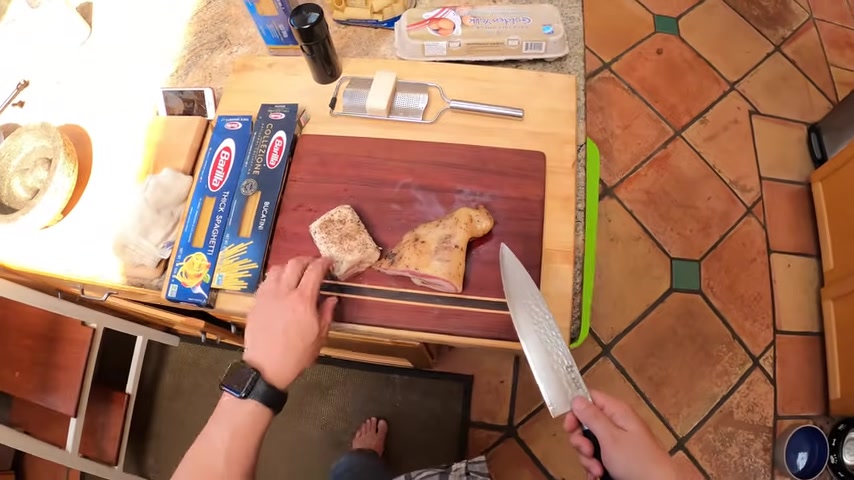
Hey , this is Kenji .
Uh Today we're gonna make spaghetti , carbonara , actually , probably .
Um it doesn't really matter matter .
Pasta with carbonara sauce is one of the Roman classics , one of the four Roman classics .
And we've already done the first three .
So we've done um Pepe , we've done um um my Italian pronunciation is terrible .
I'm sorry .
Uh um And uh are the other three .
So this one's car , it's uh it's made with , it's a sauce of eggs .
Um Pecorino , Romano or Parmesan .
Um And then , so we're gonna start with the uh the fat here .
Um So you , you have a couple of choices .
Um You know , traditionalists will say you need to use , which is the um the jowl , the cheek of the pig that's been cured with uh salt and pepper .
Um Other people will say it's totally fine to use .
I think it's totally fine to use whichever you want .
Um This is some of sous chef Eric's , by the way , um You can also use if you , if all you can get is a regular American bacon , then you know , go for it with that too .
It's gonna be just fine .
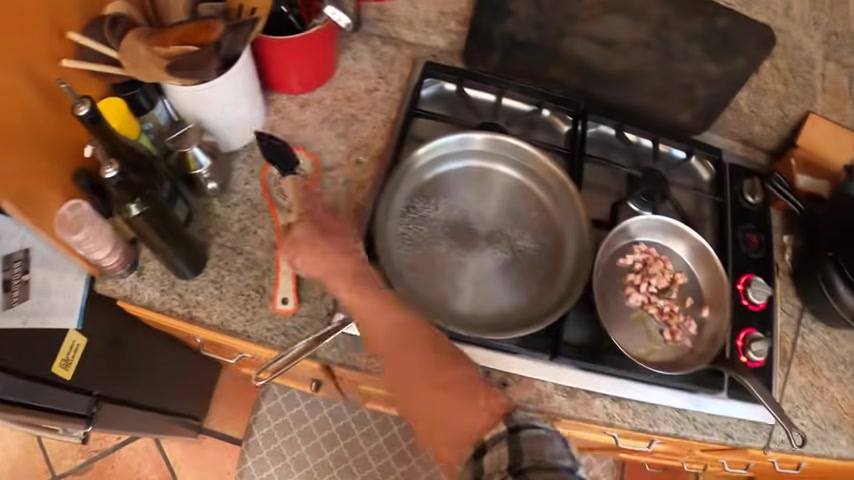
It might taste a little different .
Um Some people might tell you that it's not true carbona if you make it that way .
Um I don't really care what other people say .
Um As long as it tastes good , um I think that's all that really matters .
So we're gonna take this and we're gonna cut it into nice kind of thick um , little chunks like this .
This one is so has a kind of likely funkier flavor than um and if you see , um let me show you here .
Oh Here's one for you down there , down there .
Look .
Um and if you see uh it also tends to have quite a bit more fat like a higher fat content than regular pork belly .
So bacon um Panetta is made from belly .
Uh Guan is made from the Jowl which is a little bit fattier than the belly .
Um cut it into chunks .
I got some water going here in the skillet for that's for the pasta .
Um And then over here on this side , I got another skillet for the and that's where we're gonna finish cooking everything .
Um I'm gonna start it with just a touch of olive oil .
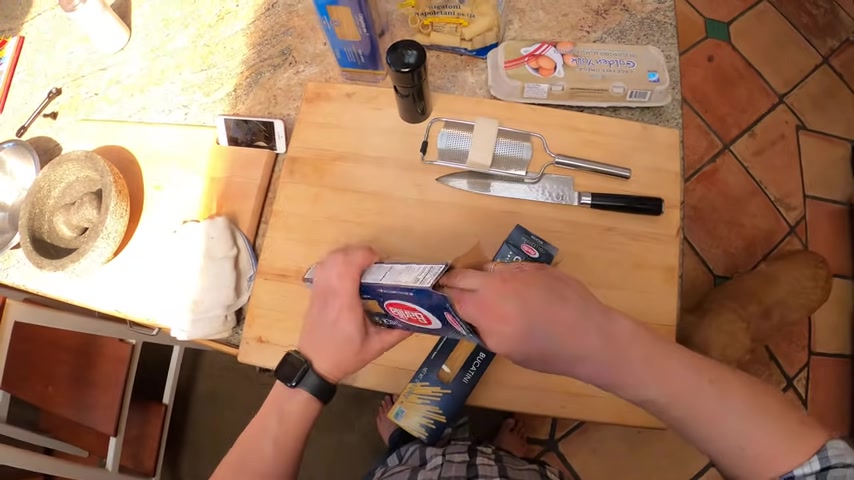
You don't need a , you don't really need to do that .
Um I just find it makes it easier to start it off .
Um So that it starts rendering and then eventually you see it's gonna start just sizzling in its own fat .
Now , let's look at the pasta .
Um So pasta , you got a few choices again .
Um So here I've got spaghetti , well , thick spaghetti , I guess what they call spaghettini , um sp thick spaghetti .
Um And here I have bucatini .
Um But between these two pastas , there's um a more significant difference than just the shape .
Uh So this one , this thick spaghetti is sort of the standard , you know , relatively inexpensive supermarket stuff , modern pasta .
Um And you can see , so this stuff is made by extruding the dough through teflon coated dyes .
Um , and that makes them go production go much faster .
Um , whereas traditional pasta is made through uh bronze dyes .
Um , and that , so it sticks a little more and it has to go slower .
But what that also means is that uh traditional pasta tends to have rougher edges , um , and more sort of free starch .
Uh And so it's going to cling to the sauce a little bit better .
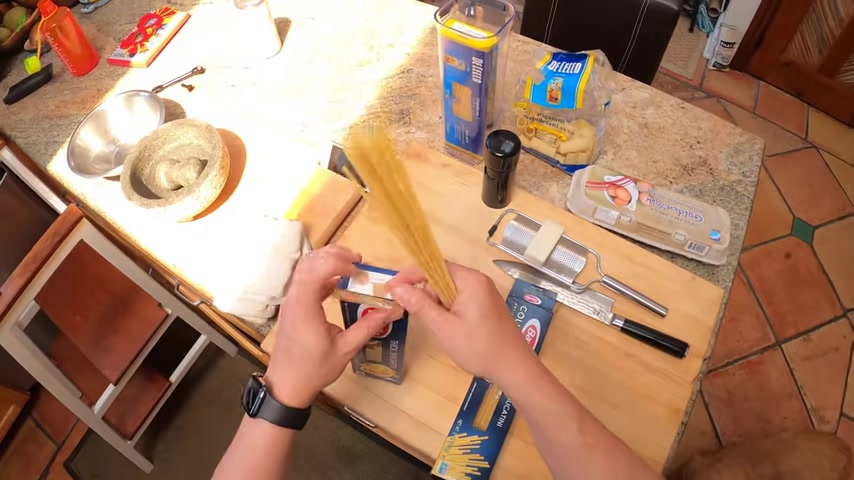
The sauce is going to cling to the pasta better than it would with , um , with uh modern pasta .
The other difference .
Mhm .
The other difference is that , um , modern pastas tends to be dried at a relatively high temperature .
And so that's what gives it , that sort of darker color , that darker yellow color .
Um , but it also deactivates the starch so that it doesn't thicken your sauce as much when you use it .
So I'm gonna go with the more old fashioned pasta .
Um , I also tend to prefer the shape of a bucca .
Um , you want to do about , about 100 grams per person , maybe 80 grams per person .
Um , I'm just making it for one right now .
That's about right for one .
I'm making it for one and I think I'll share this with my daughter .
Um , actually there's enough , there's enough , uh , goal in there for like three .
But , oh , well , uh , all right .
So pasta one , it's here , I'm gonna season it with a little bit of salt .
Not too much because it has all these other salty ingredients .
Um 01 thing neat .
Um So you might notice when I put salt in the water .
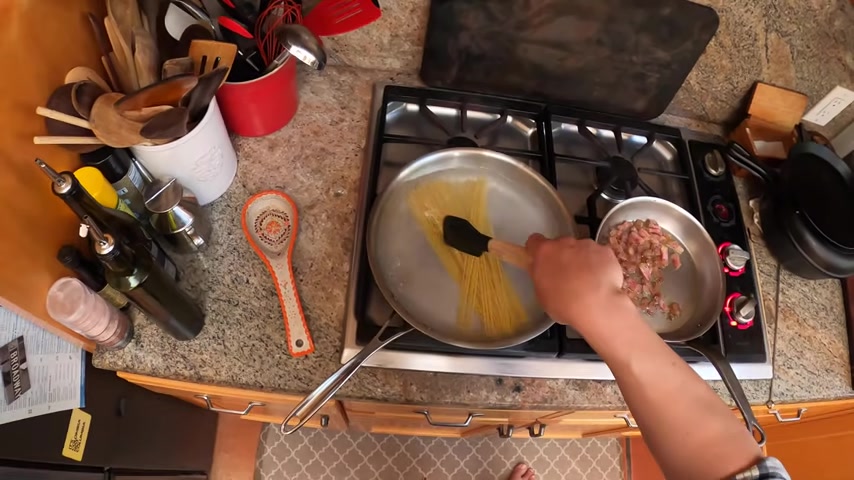
Um And you might have noticed before if you have a pot of boiling water and you pour some salt in it all of a sudden , it really vigorously boils .
Um And some people falsely say that that's because salt uh lowers the boiling temperature of water .
Therefore , it releases a bunch of gas all at the same time because you've suddenly lowered its boiling temperature .
Um Some people also say that you should wait until after the water comes to a boil before you add the salt because it makes it come to a boil faster .
Um Neither of those things are , are true .
I mean , it is technically true that salt will lower the boiling point of water .
Um but not to a measurable amount .
Um At least not to a noticeable amount with this amount of salt that you're putting in it .
Um What , what really is going on there ?
Is that what you're doing is you're adding uh Nucleation sites .
So , Nucleation sites are like um little points um where uh bubbles can form .
So , um for instance , like you , if you look at a glass of champagne , you'll see bubbles always come from the same spot .
Um And that's because there's like micro imperfection .
You actually let me show you there's micro imperfections in the glass .
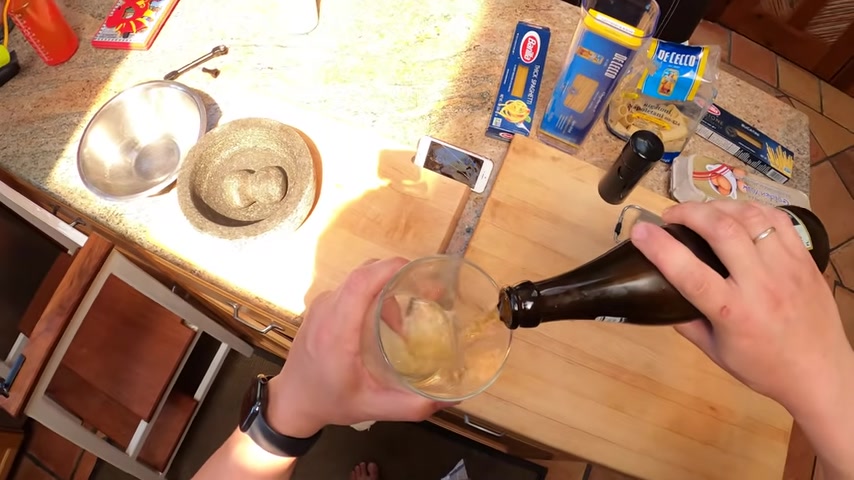
Um So this is uh we steer um oldest brewery in the world German beer .
It's excellent .
I think in another video , I made a joke and said that it was garbage or something .
Um No , it's excellent .
It's a half of um So you see not too many bubbles right now because I poured it very carefully .
Um So if I suddenly want for someone to take a sip , so I don't waste it if I suddenly want a lot of bubbles to appear , all I have to do is add a little bit of salt to it .
And what that does is it introduces Nucleation sites .
So essentially they're just points where the um the bubbles can start forming .
Uh So this is actually a trick we use when we , when we're doing photo shoots at the restaurant and we have oop pick up , sorry .
And we have a uh a beer in the shot .
It's a photoshoot .
It's taking too long .
I'm just , I got the hiccups .
Hold on a second .
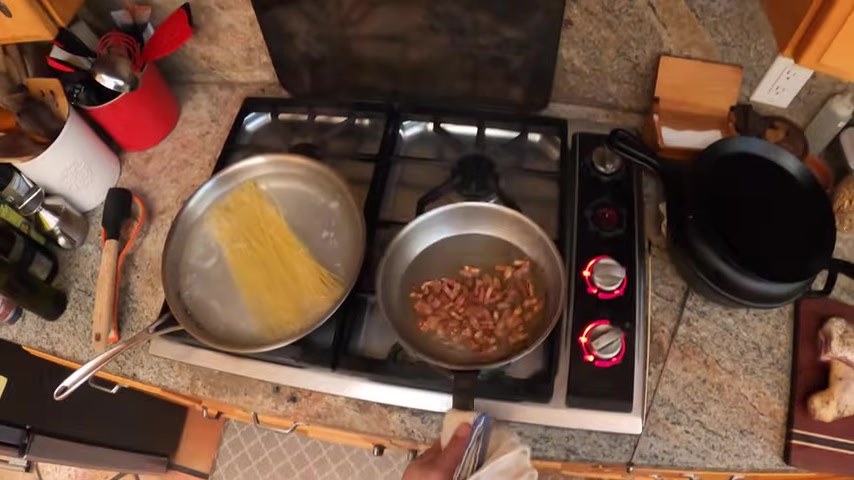
I'm sorry .
Uh , if the photo shoot is taking too long and the beer starts to lose its head .
Um , we take a little bit of salt and Sprinkle it in that beer so that we don't have to pour a whole new beer .
Um , and it makes that foam come right back , makes the photo beautiful and it makes the beer taste like salty garbage .
Um , the other place where you might see Nucleation sites or you might have heard of them is um uh vapor vapor trails from um from airplanes from jet airplanes .
So what , what those are is actually airplanes , uh the combustion , the products of combustion that are flying out of the engines .
Um Those act as Nucleation sites for the condensation of water in the air .
So if it's a moist day out , um if it's a , you know , sorry if it , if it's high humidity up there .
Um But there aren't a lot of Nucleation sites then when the jet engine passes through , it creates those sites and that's why the water condenses on them .
Um Other places where there's Nucleation sites are uh like in the early universe when Galaxies and planets were forming , they all formed around Nucleation sites .
Um All right .
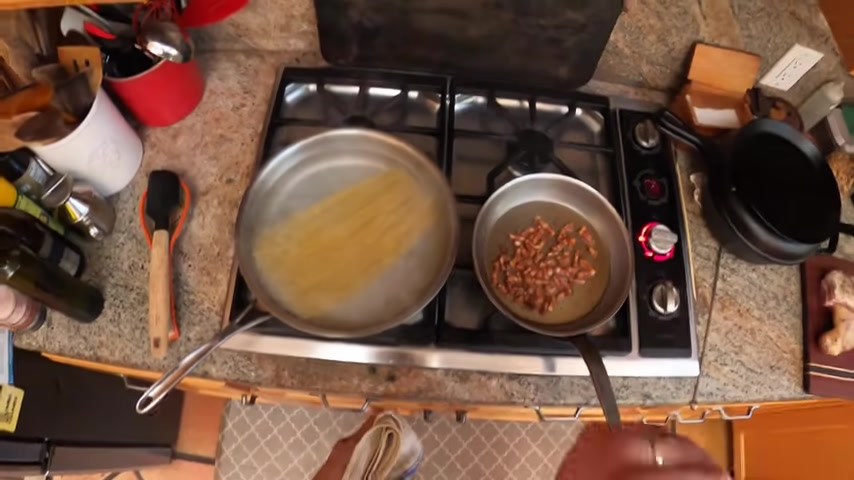
So the reason I started my pancetta before my pasta because I'm gonna turn it off heat now , while the , before the pasta is well before the pasta is done because I want this pan to be nice and cool .
Um , if the pan is too hot later on when we add our pasta and our egg sauce , the eggs turn into scrambled eggs .
Um , you don't want scrambled eggs in your , um , carbona .
Um , the first time I had heard of Carbonara actually was , um , was , uh , when I was a , a student , um , a fresh freshman year , um , when I was a student , um , and there was a , a girl um from Italy , from Rome , um Carina , if you're watching this , I don't know if you are .
Um But uh she lived in my fraternity house and um she was from Rome and uh she kept telling me about all this Italian food , Roman food and one of the ones she mentioned was Car and I was like , oh what's that ?
She's like , it's basically like spaghetti with ba and scrambled eggs .
Um Which of course it's not really and I don't think she meant it .
I think that was just kind of a lost in translation type moment .
But um it's not really scrambled eggs .
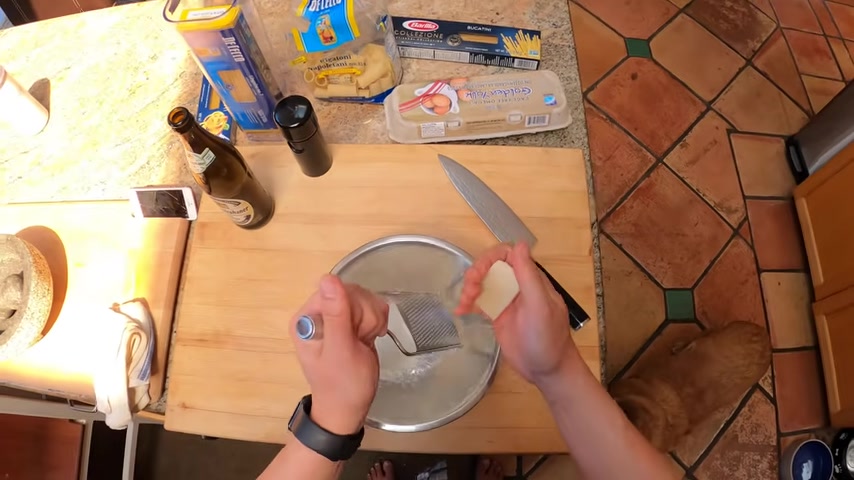
What you really want is eggs to be sort of the eggs are there to really bind the sauce um to the pasta .
It should be silky and smooth and not scrambled .
Um And she did make it for us and it was , it was delicious .
Um And that was the first time I had carbona .
Um So uh Pecorino cheese , Pecorino , Romano .
This is a sheep's milk cheese aged nice and sharp .
Um I'd say about uh about an ounce , like 30 g , maybe an ounce and a half , 45 g per person .
Um , one egg per serving also , um if you want to go like sort of extra decadent , you can add an extra egg yolk .
Um I'm not gonna do that today just because I , I don't feel like being extra decadent .
Um Plenty of black pepper .
This is a unicorn pepper mill .
Um I like them .
Uh They have the , the main thing you want to look for in a pepper mill is that it has a metal bur .
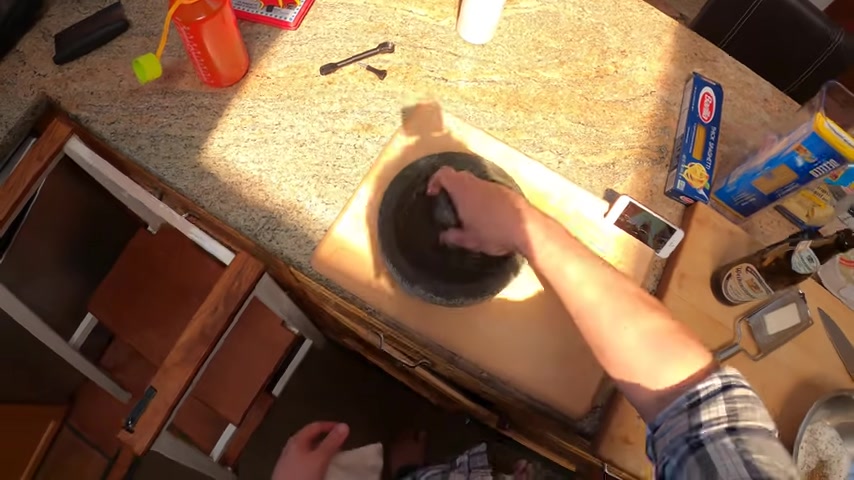
Um Actually this pepper mill is made in Italy um that it has a metal burr so that , you know , ones with plastic burs or polycarbonate burs tend to wear down over time .
Um Metal birds don't , uh the other thing you can use for the for the pepper is this .
Um And all right , so we get our eggs , we get our cheese .
No cream carbonara typically doesn't have cream although , you know , if you wanna put cream in it , I'm not gonna stop you .
I think it's just fine .
I've had carbonara with cream in it from restaurants before and even though it wasn't what I was expecting , it still can taste just fine .
Um Same thing with like other things that you'll commonly see in sort of Italian American restaurants frequently cream in the carbonara sauce or sometimes peas , um , you know , whatever .
If you like peas in your carbonara , do it .
Um , some people insist that you then can't call it .
I don't , I don't really care , call it whatever you want .
Um , as long as it tastes good to you , it doesn't really matter .
Right .
All right .
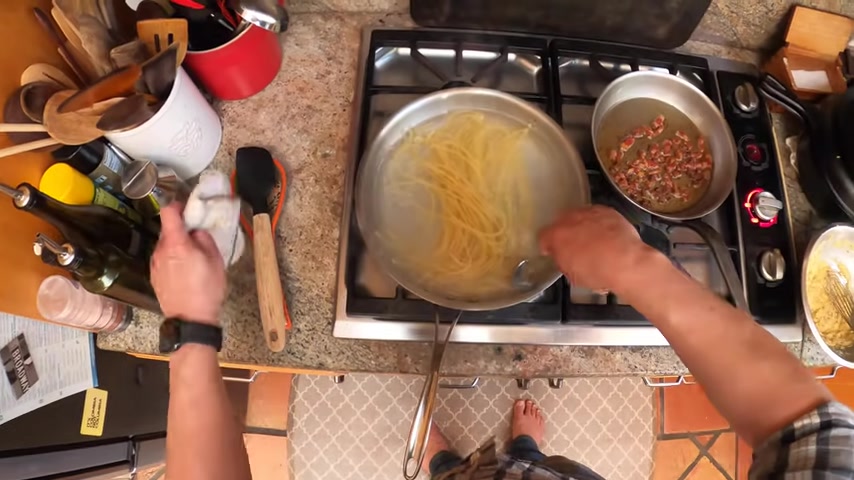
So our pasta is coming along .
Uh , the name Carbonaro , by the way is , um , it , it's , the name came after the , so the , the dish is pretty ancient .
Um So , you know , um is the oldest of the four Roman dishes that's been around for like thousands of years .
Um And that is just pasta with , uh and um with um Pecorino , Romano cheese , um peo cheese and pasta .
Um that's , that's um at some point later on the uh egg was introduced to it .
Um And then at some point after that , people started calling it um uh carbonara , but really , uh the , so the name comes from , uh it could , you know , it's , it's actually not very well known .
It could be that um , it was a common dish for coal miners to eat .
Um It could be that it was a , you know what I am gonna , now that I look at this , I am gonna add that extra yolk , screw it .
Let's go .
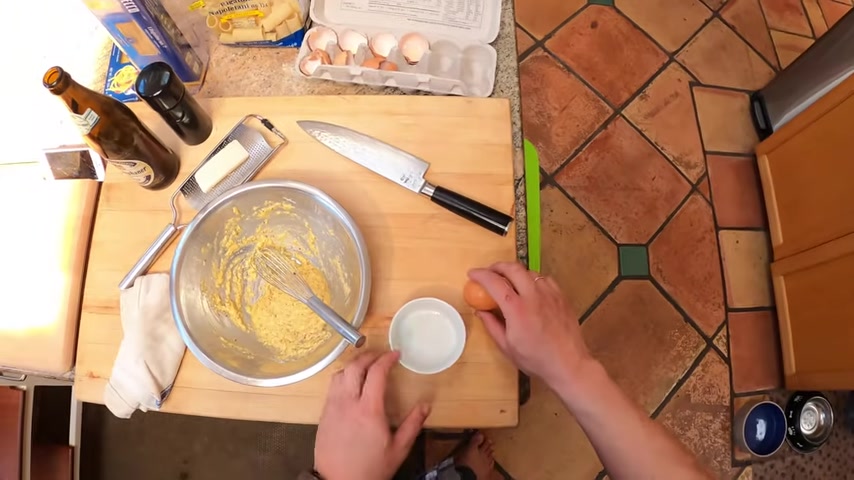
Um uh Card Bona are the coal miners .
That's the Italian name for coal miners .
I think I'm pronouncing that right .
And I think I got the word right .
Um I'm sure you'll tell me if I didn't .
Um All right , an extra egg yolk going in there .
So it could be that it's coal miners pasta .
And in fact , in parts of the US , it is called coal miner's pasta .
Um Another theory is that the little specks of black pepper represent , um , look like little bits of coal .
Um But in any case , it doesn't really matter where the name came from .
Um All we know is that , that's what it's called and that it's delicious .
Um Anybody in Rome , anybody in Rome should know how to make this dish is sort of like a , um , it's like a late night , you know , drunk table .
You come home with your friends , um , and you throw on a pot of pasta and you make , um , what am I looking for ?
What am I looking for when I get a fork ?
I only get a plate too .
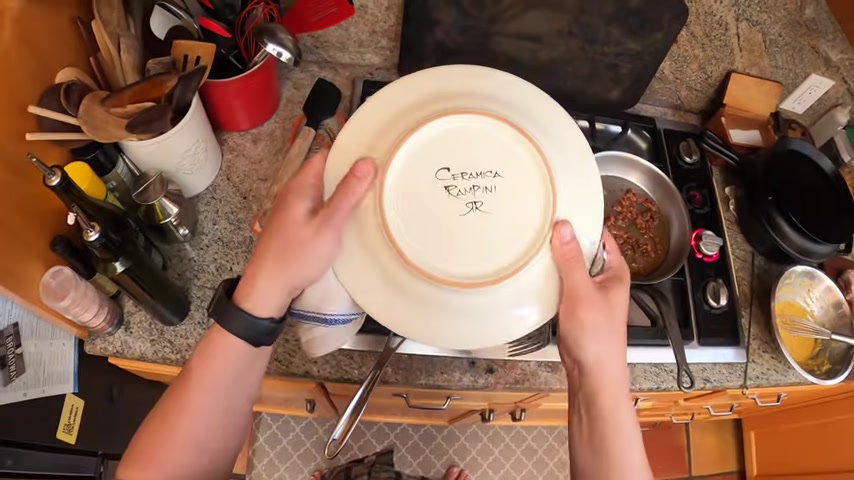
There we go .
Uh , ceramic art .
So this is a , an Italian ceramic company , but it was actually hand painted in Colombia , which is where my wife and I got it .
All right .
That's where we past is looking good right now .
Um So right now it's , um , it's uh where my , where my tongues go .
Oh , well , it's , um , it's Al Dente a little bit just shy of Al Dente , which is where we want it .
Um , because if it gets too , just like sort of scrambled eggs , like if your pasta is perfectly cooked in the pasta water .
Then it's gonna overcook by the time it's done cooking in the sauce .
Um , so we want it to be just , just shy of al Dente when we add it to here and this is just right .
Yeah .
Right .
So it's got some pasta water in there .
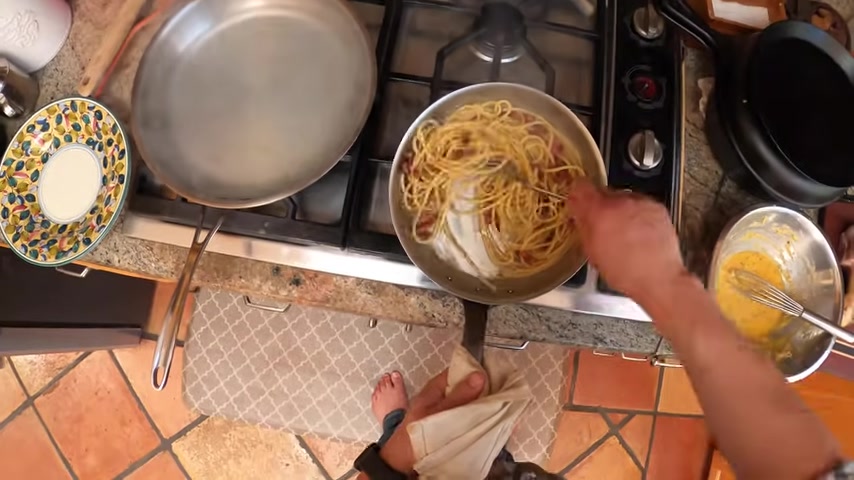
Um , that pasta water you can see is nice and starchy and in fact , I'm gonna splash a little bit more , just a little bit more .
That's the sort of magic ingredient that's going to help our sauce bind together .
Um So pasta water , you can see that it's already um you saw how much sort of fat was in there from that rendered fat from the guana and you can see that it's already not greasy , right ?
The um the pasta water helps it mul into a sort of creamy sauce and that's exactly what you want .
So now we're ready to add our egg mixture once the egg mixture goes in there , um you gotta keep moving it .
Um And you want to make sure that your pan is relatively cool .
Uh My , my colleague at series Eats Daniel Gritz .
He has a technique where um he dumps everything into uh into this pan .
Uh and then does it over a double boiler to slowly thicken it up , which you can do if you're real .
You know , if you , if you've had trouble with carbonara in the past and it turns into scrambled eggs .
Um you can definitely use that method and it , and it helps .
Um , it's just a little slower and I don't feel like being slower today .
There you go .
And that's essentially it .
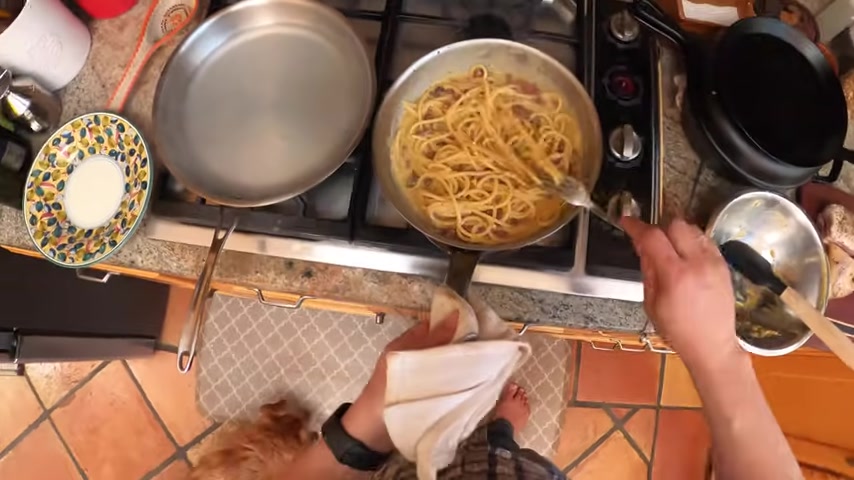
We are done .
Let it thicken up .
Just a tiny bit more , tiny , tiny bit more .
Oh , probably could have done with just a little bit more pasta .
I tend to always overdo the amount of sauce .
Um , the Disney , but the nice thing about it is that , oh , sorry .
So you see how , how glossy and creamy it is .
Um It's not uh it's not wet , it's not greasy , it's definitely not scrambled .
Um That's really what you're looking for .
Yeah .
Yeah .
Um I'm just gonna pull it since I made a little bit too much sauce .
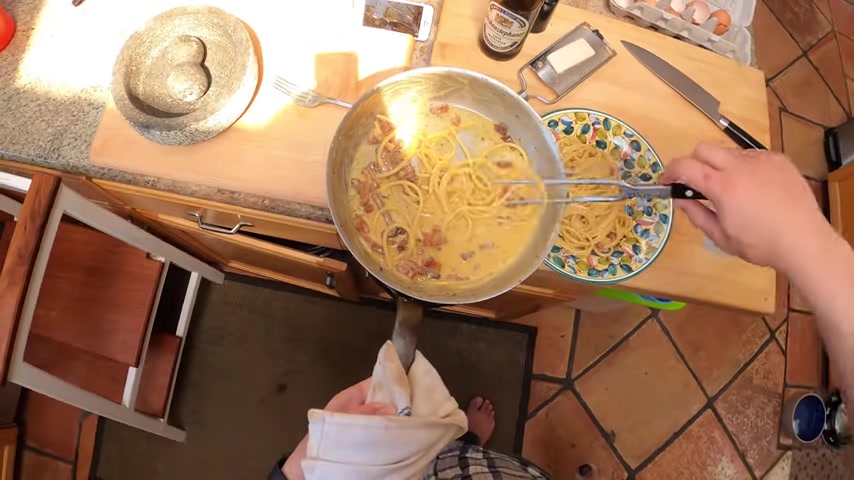
I'm just gonna pull the , the bucatini kind of through it to coat it in the sauce and then we'll spoon over the excess and then what I'll do is I'll save this sauce for later and when my wife gets home , she will have um I will cook some more pasta for her and she'll use it up .
Oh , hold on a second .
Alicia .
Meanwhile , my daughter and I are enjoy this batch .
Hm .
A little extra pepper .
We got a tiny bit left with that Rio left , right .
So here we go .
This is classic Bucca tini .
Oh man .
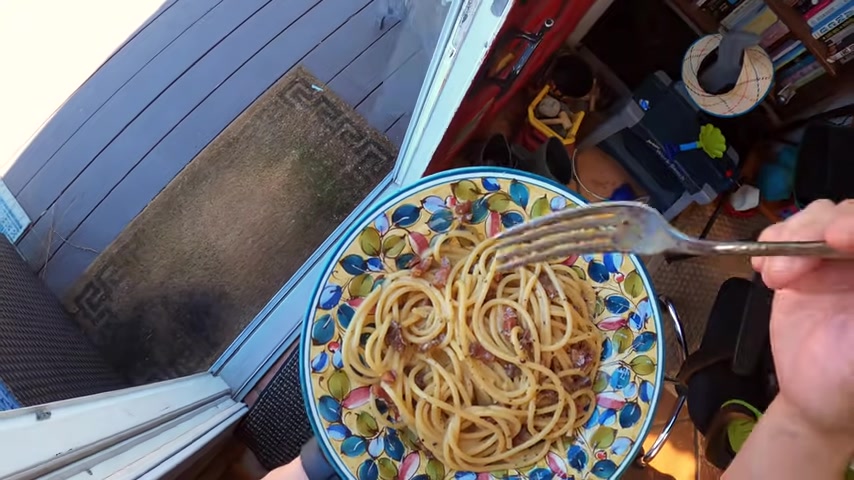
Hm .
I'm so good .
Charlie's .
Hm .
The thing that Guan Charli brings up um Pancetta doesn't , is that because it's so high in fat , you get that kind of crispy shell on the outside , that kind of just melts away in the middle .
It's kind of like a , it's like the gushers of bacon , you know .
Mhm .
Yeah .
Pork dishes .
You , so , and when you want one you go with him .
All right .
All right .
My daughter's waiting , I'll see you next time .
Are you looking for a way to reach a wider audience and get more views on your videos?
Our innovative video to text transcribing service can help you do just that.
We provide accurate transcriptions of your videos along with visual content that will help you attract new viewers and keep them engaged. Plus, our data analytics and ad campaign tools can help you monetize your content and maximize your revenue.
Let's partner up and take your video content to the next level!
Contact us today to learn more.